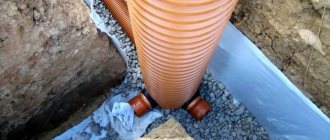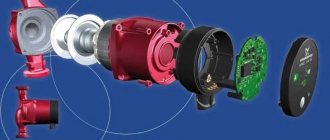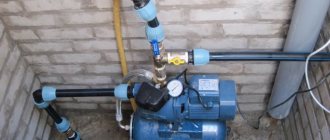Drainage pumps are indispensable assistants in solving many problems related to water transportation. Thanks to their compact dimensions and ease of installation, these “universal soldiers” will help you quickly cope with any problem - from pumping unclean water from a well to draining an area.
In order for the unit to cope with the tasks assigned to it, and for the purchase to justify itself with uninterrupted operation, it is necessary to carefully approach the issue of choosing a device.
We will tell you how water drainage pumps work and which models are appropriate to use in a given situation. In addition, we will identify reliable equipment manufacturers and list the main criteria for choosing drainage pumps.
Drainage pump: what is it?
A drainage pump is a device that can pump out large volumes of water. It is functional and suitable for use in various conditions. The only condition limiting the scope of application of the device is the amount of impurities in the water. It should be less than 10%. Failure to comply with this requirement will result in pump failure. The device lifts water a short distance. This is due to the fact that the functionality of the drainage pump does not allow creating high pressure. The peculiarity of this type of device is that its repair is a rather labor-intensive procedure. It is rarely possible to troubleshoot a drain pump on your own. The device has a wide range of applications. Thus, a drainage pump pumps out or removes fecal wastewater in multi-story buildings. For these purposes, special device models are produced. The operating principle of the drainage and fecal pumps is the same. However, there is one difference between these types of devices. The drainage pump works normally with impurities whose diameter is 12 mm. In the case of devices used when working with sewage, foreign particles in diameter can reach 120 mm. Cutting knives are often additionally installed inside such pumps. They crush impurities, which prevents hoses from clogging. At the same time, fecal pumps pump liquids that contain virtually no impurities or suspended matter.
Exploitation
Choosing the right drainage pump is only half the battle. How successfully and long it will be used depends on compliance with the operating rules:
- the unit cannot be used in water with solid impurities the size of which it is not designed for;
- It is prohibited to pump explosive and flammable liquids (for example, gasoline);
- It is not recommended to move the equipment during operation;
- The technical data of the pump must correspond to the scope of its application (performance, depth, degree of contamination of the liquid are taken into account).
Drainage pumps: what are they?
Depending on the operating conditions, drainage pumps can be, for example, submersible.
During operation they are in water. Such a pump is used to raise liquid to a considerable height. This is possible thanks to the high power of the device. Compactness and noiselessness are the main advantages of such a drainage pump. Its diving depth reaches 50 m. However, this species also has disadvantages. Submersible pumps are difficult to repair. This is explained by the fact that it is quite difficult to open the device’s case, as well as to find the cause of its breakdown. To eliminate the malfunction, you have to remove the device from the water, and this is a rather labor-intensive process that can only be carried out by an experienced specialist. The operating principle of a submersible drainage pump is similar to an external pump. Although there is one difference in their functioning. It consists in the fact that the submersible pump itself sucks in the liquid. In an external type device, this process is carried out through a hose. To suck in water, the bottom of the submersible pump is equipped with special holes, after which mesh filters are located inside the structure. They provide the impeller with reliable protection from large impurities and stones. Another advantage of a submersible pump is that it does not need to be turned on. It begins its work when the effluent reaches a certain level. When using, it is important to properly isolate the pump from the liquid to prevent a possible short circuit. It can be used not only for household but also for industrial purposes. Submersible pump is also classified into the following types:
- vertical – maximum immersion depth is 7 m;
- horizontal – immersion depth is more than 100 m.
The submersible pump is very easy to use as it does not require a cooling system. Liquid passes through it, and due to this, excess thermal energy is lost. The device can be used at any temperature. Even severe frosts will not interfere with its work. The main thing is to install the pump correctly. Problems often arise during the installation process, since the device must be lowered to great depths. A subtype of submersible type device is a semi-submersible pump. Its working part is completely in the water, and the engine remains above it. The device is not suitable for pumping liquids that contain large particles. Drainage pumps are also surface pumps. Devices of this type are installed in wells and boreholes. The surface pump is not immersed in liquid. Water enters it through a long hose. The pump is suitable for use in conditions where the liquid is at shallow depths. Most often, the device is used for pumping groundwater. The ease of installation and dismantling of the surface pump is one of its main advantages. Maintenance of the device is also convenient. The main structural elements must be cleaned and lubricated from time to time. This will prevent device breakdowns and increase its service life. All types of pumps have a special float. Using this part, the liquid level is monitored. When it reaches a critical point, the pump begins to pump out water. The device can be easily transported from place to place if necessary. High mobility and compactness are one of its advantages. In terms of functionality, a surface pump is inferior to a submersible one. However, they consume the same amount of electricity. A surface pump cannot be used to pump water from great depths, which significantly limits its scope of application. Another disadvantage of the device is that it heats up quickly and makes a lot of noise during operation. The service life of a surface pump is significantly shorter than that of a submersible pump.
Criterias of choice
To choose a high-quality drainage pump that will meet your requirements and can do its job effectively, you need to carefully consider the choice of equipment.
Consider the following nuances:
- You shouldn’t chase too much power; it will affect the tool’s parameters, power consumption, and rapid heating of the equipment. As a rule, pumps of this class are designed for a regular 220 volt network, and the power starts from 350 to 400 W. Three-phase models are used very rarely by private individuals.
- It is especially important to take into account the coefficient of liquid pressure created at the outlet. It is measured in meters of water, technical atmospheres or bars. The pressure must be sufficient not only to raise the water, but also to overcome the hydraulic resistance of the horizontal elements of the pipe.
- Be sure to know the maximum depth to which the equipment can be lowered.
- The higher the productivity, the higher the liquid pumping speed.
- Please note that some pumps are not capable of handling large solid deposits. Choose a knife rather than a cutting edge.
- Pressure and immersion depth - the height of the pumped liquid rises depends on these indicators.
- It is worth studying carefully the operating features - how to care for the equipment, how to change its elements and repair it.
Drain pump design
The main element in the design of the pump is its electric motor. The volume of water that can be pumped per unit of time depends on its power. The electric motor starts working as soon as the device is connected to a source of electricity, which is often a gasoline generator. Simultaneously with the electric motor, the work of the shaft with the rabbit begins. First, the water enters the pump and then exits through the hose. Its movement inside is carried out due to the action of centrifugal force. Another important design element is the float. It provides automatic switching off and turning on of the device. If there were no float, the user would have to constantly monitor the process of pumping liquid. After all, if the pump ends up completely immersed in water or works when the water in the tank has already run out, this may cause a breakdown. Large particles or stones getting inside the structure also leads to pump failure. To prevent this, you should carefully read the technical characteristics and design features. The user manual contains information about what impurities are acceptable. If the device is not designed to pump water containing large particles, then it will not be suitable for working with contaminated liquid.
Operating principles and installation
Installation of equipment must, first of all, begin with measuring the current level; it must be below the permissible level. Experts advise mounting the float in a recess.
For installation you will need a cable and a small weight, which is included in the kit:
- the load is strung on a cord, after which the stroke of the float is determined;
- the latch will secure the weight;
- the cable is fixed from the outside;
- the switch is connected to the pump.
You can install the float yourself only if the equipment does not hang inside the container. If several floats are installed at the same time, they are placed in a special rod. A plastic tube is used for this. For proper installation, you need to set the float yourself, adjust it, install it so that the operating radius of the floats does not touch, and secure the cables with clamps.
The device installed in the system can be connected to the float in two ways:
- if the power is less than 1.2 kV, then it is connected directly via a network cable;
- if the power is higher than 1.2 kV, the connection is made through an electromagnetic relay or other switching link.
The float switch works as follows:
- A pump with a built-in float when filling the tank turns off the switch upon ascent, when the tank is completely filled with water. When lowered to the bottom, the equipment will turn on when the tank is empty.
- If the tank is completely filled, the float switch will be on the surface and the equipment will operate automatically. When the reservoir is empty, the device will stop working.
- The switch gives a command and the valve closes when raised to the surface. In such a situation, the tank fills up. When it hits the bottom, the valve opens and the container is emptied.
Operating principle of the drainage pump
Anyone can understand how a sump pump works. The device pumps out water, which is discharged to a specially designed treatment facility. The complexity of installation directly depends on the immersion depth of the pump. Models located near the surface are easiest to install. In some cases, the operation of the device is limited because the water it pumps out is at a high temperature. As a result, the pump heats up, which complicates its operation. Manufacturers of drainage pumps usually indicate in their instructions the maximum temperature at which each model can operate. Some devices are designed specifically for use in special conditions. For example, for working at high temperatures (more than 50 degrees).
Advantages compared to other pumps
- Affordable price
(At a relatively low cost, the drainage pump has quite a lot of power. Some models are capable of pumping up to 8 cubic meters of liquid per hour. The pump pressure is about 7 m. Such technical characteristics allow the device to be used in everyday life. For example, using a drainage pump you can It's easy and quick to change the water in your home pool.) - Simplicity and ease of operation
(Surface pumps are easy to install and dismantle. Submersible type devices require more time to install, but can be easily handled without assistance. The drainage pump operates silently and is lightweight. Compact dimensions allow you to quickly move the device from one place to another other.) - Long service life.
(Drainage pumps are very reliable. They have a simple design, the parts of which, if the operating rules are followed, rarely fail. If the level of the pumped liquid reaches a certain value, the drainage pump will automatically turn off. This function allows you to extend the life of the device, prevent motor breakdown and save energy. )
Using a drainage pump at home
To start using the drainage pump, you need to hang it by the handle. If the device is installed on a flat surface, such as the bottom of a pond, you must use a stand. This will prevent soil from getting into the impeller. Sand from the bottom of the reservoir also negatively affects the operation of the device, reducing its service life. There is a special grill at the base of the pump. Water is pumped into the device through it. The size of the holes in the grid determines how large the impurity particles in the liquid can be. After starting the device, you need to constantly monitor the temperature of the pumped water. It should be less than 40 degrees. Household drainage pumps are connected to an electricity source with a voltage of 220 W. In order for the device to work longer, it should not be used to work with liquids that contain more than 10% impurities. The functionality of the drainage pump is limited by the need to connect to a source of electricity. To make the device more mobile, you can use a gasoline generator.
Where is the drain pump used?
- In industry
(For work in large enterprises, the most powerful models are needed. They are used to pump out industrial wastewater and rainwater. Pumps in factories are part of the emergency system. Devices for industrial use are highly reliable and wear-resistant. These characteristics, along with efficiency, are the main ones when choosing specific model. - In construction
(Draining of pits at construction sites is carried out using a drainage pump. The device, as when used in industrial enterprises, must be sufficiently powerful and reliable.) - In everyday life
(Low cost and excellent performance characteristics allow the drainage pump to be used for various purposes in everyday life. The device will become an indispensable assistant for owners of personal plots. The drainage pump allows you to solve the problem of flooding of the basement and cellar. Those who have a swimming pool will definitely appreciate the advantages of the device . Changing the water in a tank with a drainage pump will be easier and faster. During its operation, you do not need to be constantly nearby. The pump turns off automatically. The device can also be used for watering crops in a personal plot.)
How to disassemble a float
Sometimes the reason that the pump does not want to work lies in a malfunction of the float mechanism. It is intended to protect the device from dry operation. To repair a drainage pump with a float, you will need to disassemble this device and inspect it from the inside. To open the float, unscrew the connecting bolts on its body, then pry off the connecting seam with a screwdriver. Inside there is a freely rolling ball, the movement of which turns on/off the power supply.
Read also: Connect an illuminated switch with one key
It happens that the ball stops spontaneously, blocking the engine from starting. Sticking can also be caused by the float body losing its seal, as a result of which the ball rusts or becomes overgrown with mineral deposits. To correct the situation, you need to clean it and properly seal the seams.











